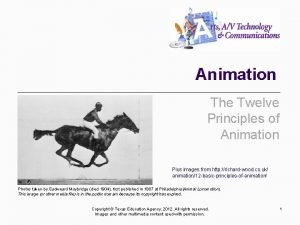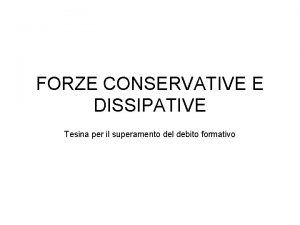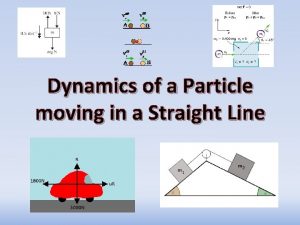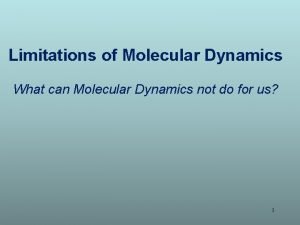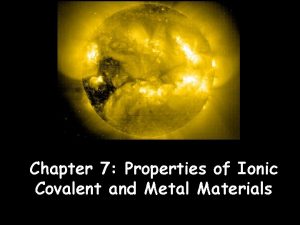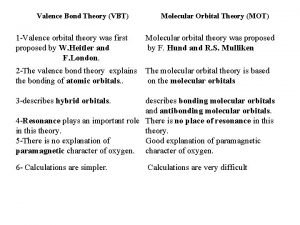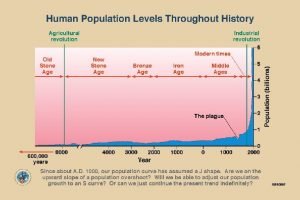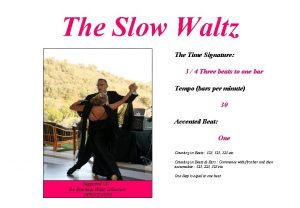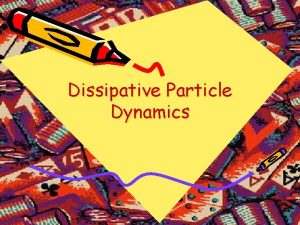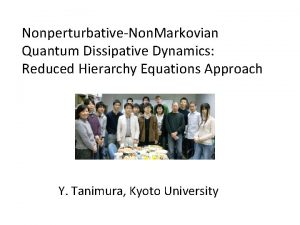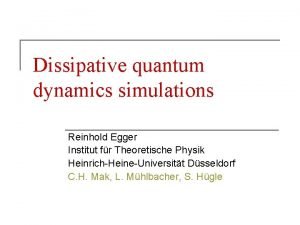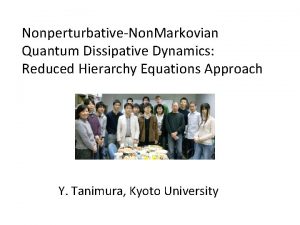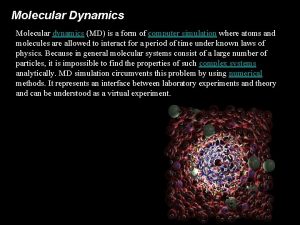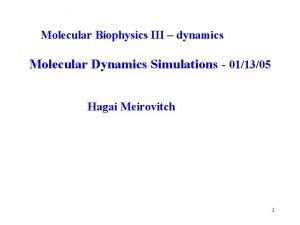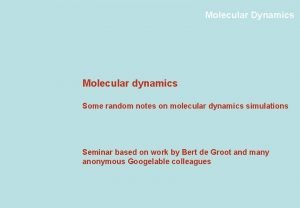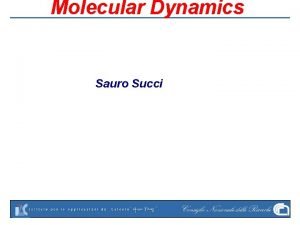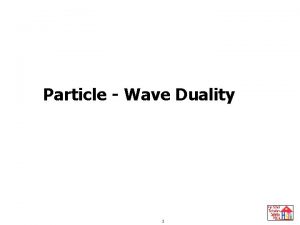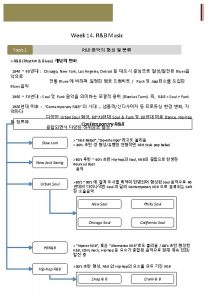Dissipative Particle Dynamics Molecular Dynamics why slow MD

















- Slides: 17

Dissipative Particle Dynamics

Molecular Dynamics, why slow? • MD solves Newton’s equations of motion for atoms/molecules: • Why MD is slow?

Length, Time, & Energy Scales • Look at typical scales of carbon-based molecules: length 1 Å, mass 12 amu, spring constant k = 20 e. V/Å2 with a Hamiltonian • What is the associated equation of motion and time scale?

Hamilton’s Equations • From • We get dp/dt = - k x, dx/dt = p/m • Or • The solution is a harmonic oscillation x(t)=Acos[ (2 t+δ)/T ] with time period

Time Scale We use the units conversion factors: 1 milli sec = 10 -3 sec 1 e. V = 1. 6 x 10 -19 joule 1 μs = 10 -6 sec 1 amu = 1. 66 x 10 -27 kg 1 nano sec = 10 -9 sec 1Å= 10 -10 meter 1 pico sec =10 -12 sec 1 femto sec = 10 -15 sec

How to increase the time scale of MD? • Increase mass m, instead of simulating a single atom, we simulate a lump of them. • Decrease the interaction strength k, we make the interaction softer.

Lennard-Jones vs Soft Pair Potential V(r) LJ Linear soft repulsion r

Brownian/Langevin Dynamics - p is a dissipative (frictional) force, R(t) is random force with zero average and δ-function correlated in time (white noise). Bold face for vectors.

How to solve an equation with random forces? Where is independent Gaussian random variable with zero mean and variance 2 mk. BT h. (Why? )

Statistical Ensembles • Micro-canonical ensemble: fixed particle number, volume, and energy (N, V, E) • Canonical ensemble: fixed particle number, volume, and temperature (N, V, T). Langevin dynamics implements a canonical ensemble.

Dissipative Particle Method • The dissipative particle dynamics was first proposed by Hoogerbrugge and Koelman (1992) for simulating hydrodynamic behavior. It was further improved by Groot and Warren (1997). It is a molecular dynamics with pair forces of three types.

DPD equations The forces are pair-wise additive, with conservative force FC, dissipative force FD, and stochastic force FR.

Conservative Force • V(r) = (1/2) a (r –rc)2, r < rc = 0, r ≥ rc Where r is distance between two given particles. What is the form of the force acting on particle i from particle j ?

Dissipative Force and Random Force

Velocity-Verlet Algorithm What value to take? Order of accuracy?

Application of DPD method • Coarse-grained description for solutions (e. g. , water), simulating polymers (e. g. , DNAs) in solution. • Complex fluids at hydrodynamic time scales. • Suspension of hard objects (spheres, rods, etc) in fluids.

Smoothed Particle Hydrodynamics • A typical class of methods where continuum field equations (such as hydrodynamic equations) are simulated using the concept of particles. • The traditional methods was to solve the partial differential equations on a regular grids (in space and time).
 Slow in slow out animation
Slow in slow out animation Forze dissipative
Forze dissipative Hey bye bye
Hey bye bye Giant molecular structure vs simple molecular structure
Giant molecular structure vs simple molecular structure Ionic covalent metallic
Ionic covalent metallic Giant molecular structure vs simple molecular structure
Giant molecular structure vs simple molecular structure Dmca advisory
Dmca advisory Dynamics of a particle moving in a straight line
Dynamics of a particle moving in a straight line Molecular dynamics limitations
Molecular dynamics limitations Dont ask
Dont ask Particle theory melting
Particle theory melting Why are molecular compounds poor conductors
Why are molecular compounds poor conductors Similarities between vbt and mot
Similarities between vbt and mot Slow carbon cycle
Slow carbon cycle Slow growth age structure diagram
Slow growth age structure diagram A time signature used for waltz turn
A time signature used for waltz turn Fast clock to slow clock synchronization
Fast clock to slow clock synchronization Slow way home
Slow way home
